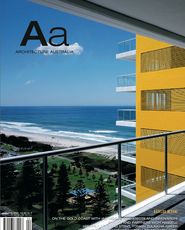Drew on the Opera House
In 2000, Jørn Utzon said, “If you suddenly make windows in that platform it becomes an office building with something white on top.” He has now done just that with the completion of the Western Loggia (see Architecture Australia vol 95 no 3 May/June 2006).
More recently, the loggia has been rented out as Cafe West, with 80 seats that obstruct any views of Sydney Harbour from the new Western Foyer.
The trabeated form of the new colonnade has little in common with the Sydney Opera House, which is possibly why it was isolated from the platform as a kind of vorbau or fore building. Even so, this attempt to dissociate the new addition from the existing structure is insufficient and only further highlights the incongruity of the loggia.
I am reminded of an elderly man I saw peeing in the middle of the square in front of Santa Croce, Florence. For privacy, he held a large handkerchief in front of himself. There was nothing obscene about his privates, but there is about the loggia. It draws attention to the mistake of making windows and Utzon’s unexplained disregard of his own sensible advice. The loggia is a foreign object bearing little relationship to the shape of the platform or the beautiful beams of the original Opera House. If only Utzon had visited the Opera House prior to proceeding, perhaps he would have realized how wrong the loggia is.
One hoped for something better and more in keeping with the spirit of the Opera House. The loggia is a sad conclusion to a great and valiant career in its twilight, with Utzon now 88 years old. Not only does the Western Loggia fail to add anything positive to the House, it detracts considerably without serving any detectable function as either a gallery walk or sun protection. Sydney already has more than enough restaurants, especially around East Circular Quay. Why do we need yet another, especially considering the sensitivity of its location?
Sandra Kaji-O’Grady concludes her review, “It [the Opera House] is sufficiently robust and imperfect to take on this and other considered additions, each adding something to its story.” This is more a pious political hope than an accurate observation and entirely misunderstands the nature of Utzon’s great achievement in creating a building that was conceived to be seen from all sides and from above. The very three-dimensionality of the Sydney Opera House prevents it from being either added to or detracted from without destroying this sculptural integrity. One would no more contemplate adding an extra arm or hand to Michelangelo’s David. This same reasoning can be applied to the Opera House, which conforms to the same Renaissance aesthetic definition of plastic perfection. The idea that it could be added to is typical of a bureaucrat or ticket collector, not an artist. There have been a great many mistakes and the Western Loggia is the most recent, as Eric Sierins’s photographs testify.
The Opera House’s division into two discrete parts makes it enormously difficult – virtually impossible – to add to it. The “Group of Thousand Columns” at Chichén Itzá in the Yucatán is not a colonnade but a revolutionary attempt to create a deep room focused on an altar. As such, it is not typical of Mayan architecture and is entirely irrelevant in the Opera House context. To use it to justify the loggia is a symptom of the desperation that was felt in justifying something so clearly useless and foreign.
In Denmark, where the Utzon name is akin to royalty, Danes have not felt constrained in criticizing ill-advised projects for commercial developers by Utzon Associates in the late 80s and 90s that led to their rejection. They are architecturally mature, unlike Australia, where all criticism has been stifled by the mere association of the Western Loggia with his name. It is time we grew up. How can we possibly promote democracy to the outside world when we suppress dissenting voices in Australia?
Philip Drew is the author of three books on the Sydney Opera House, including an internationally awarded monograph published by Phaidon and a biography of Utzon.
Is a unified architectural profession a non sequitur?
In the late 80s several former RAIA national presidents were invited to meet in Melbourne to discuss the future of the profession and the role of the RAIA. Among those present were Peter McIntyre, John Davidson and the late Peter Johnston.
The overwhelming conclusion of that meeting was that the success of the RAIA depended on the ability of the Institute to unite the profession. It was noted that, in spite of being formed in 1929–30 as a single corporate entity, the RAIA’s efforts had been fragmented and disunited by interstate rivalry. RAIA activities and actions were duplicated, resources wasted and corporate knowledge lost through a lack of coordination and proper administration.
These issues were addressed in the early 90s. The interpretation of the RAIA motto Artem Promovemus Una (United we advance architecture) was rediscovered and, as a result, the RAIA underwent a governance restructure followed by a management and administrative restructure. The object of this process was to create unity of purpose and efficiency of operation.
Those of us who participated in that process were fired by the belief that a united architectural profession could be a powerful force in political and construction industry affairs. We believed that as a leader of the design professions, the RAIA would be a major influence on the decision-making process that determines the quality of the built environment.
With this background, I now watch bemusedly the fragmentation of the profession that appears to be gaining momentum.
When an RAIA National Councillor (Chapter President) publicly claims a lack of support from the national office and argues that his chapter is superior to others in terms of operation and management, it is clear that the RAIA is reverting to its former bad habits (Architect Victoria June 2006).
There are only about 12,000 registered architects in Australia, but there are now three national associations of architects: Australian Architecture Association (AAA), Association of Architects Australia (ACA-A) and the RAIA (which appears constantly at risk of becoming a national office with eight chapter organizations). Also at a national level, the Architects Accreditation Council of Australia (ACAA) attempts to coordinate the work of eight sovereign State and Territory Architects Registration Boards, all seeking to redefine themselves under new or revised legislation. This represents a relatively high level of fragmentation for a small, knowledgeable and skilled, but generally grossly underpaid, profession.
In a society that has been indoctrinated with the manner and ethics of commercial competition, the architectural profession needs to unite under one banner. The RAIA is best placed to convene this unity, primarily to advance architecture but also to advance architects.
Michael Peck, AM LFRAIA, is a former RAIA National president and a former CEO of the RAIA.
FIXES
• Kate Cullity tells us that the credits for the North Terrace Redevelopment (AA March/April 2006, vol 95 no 2) should have included Ecological Engineering, the Water Sensitive Urban Design consultants.
• Lourens West writes that Perth’s Playhouse Theatre was designed by Krantz and Sheldon, not Peter Parkinson as stated in the review of the CentreStage competition (AA March/April 2006, vol 95 no 2).
• FJMT points out that credits for the Blacktown Library (AA May/June 2006, vol 95 no 3) incorrectly included a credit for landscape architect Pittendrigh Shinkfield Bruce, who was not involved in the project.















